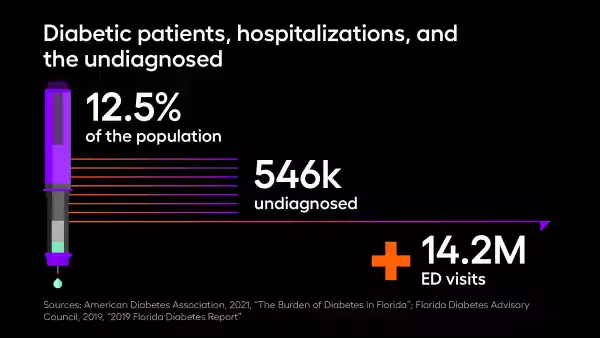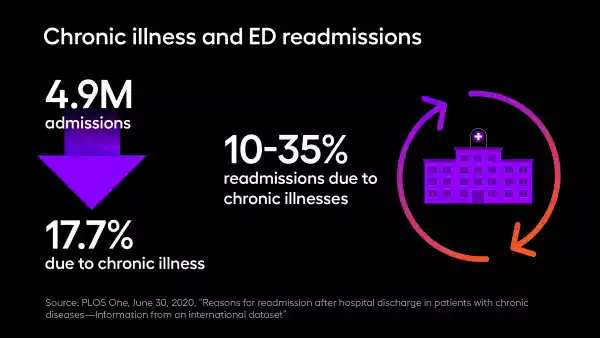How data analytics can help Florida healthcare organizations work smarter
With limited resources come major constraints, but data analytics can help Florida healthcare systems choose the most effective interventions.
Florida’s healthcare challenges are unique. It's the fourth most expensive state for healthcare, 21.3% of the population is elderly, and it's facing a shortage of 59,000 nurses by 2035.1, 2 But data analytics can help clear even these difficult obstacles. Read on to learn how organizations in the Sunshine State can use data to improve efficiency and patient health.
4 major healthcare challenges in Florida
Florida’s demographics dictate many of its greatest healthcare hurdles. Here are some of the frequent challenges the state’s healthcare systems encounter, and why they make healthcare delivery more difficult:
1. Diabetes

As of 2021, 12.5% of Florida’s population (that’s 2,164,009 people) had received a diabetes diagnosis. Another 546,000 likely have the disease but remain undiagnosed.3 Many serious comorbidities come with diabetes, from hypertension4 to ischemic heart disease.5 Most crucially, diabetes is a serious cause of hospitalizations, with 14.2 million ED visits due to diabetes in the state in 2014.6
2. Cancer

Rates of cancer in Florida are slightly higher than the US average.7 Certain statistics are even more variable — for example, only about 48% of Floridians were up-to-date on HPV vaccines as of 2021, compared to the national average of about 59%. As a chronic illness, cancer requires regular intervention and patient engagement. Education can prevent certain risky behaviors (like smoking)8, but screenings and routine care are key to avoid high costs.
3. An aging population

As of 2022, nearly 5 million9 Floridians received Medicare or Medicaid. This older population often faces a higher rate of chronic conditions,10 which lead to higher rates of hospitalization and a more frequent need for care. There are also other barriers to treating an elderly demographic, like access to transportation, isolation, or even digital literacy.11, 12, 13 If patients don’t treat their chronic illness (or can’t overcome these obstacles), this leads to more costly visits for acute care.
4. Readmissions and frequent ED visits

High readmissions rates are a costly and documented problem in Florida.14 There’s a relationship between chronic illness (like diabetes or cancer) and readmissions, so these issues go hand-in-hand.15 Avoidable return trips to the hospital inconvenience everyone, from patients to healthcare system administrators, and they take up resources and time.
4 ways data analytics helps Florida conquer health obstacles
Without data, healthcare organizations have a limited view of the populations they serve. With data, they get the full picture, from population health to granular patient insights. Here’s how a healthcare data platform mitigates problems, promotes better workflows, and improves care:
1. Patient stratification
The first step to solving a problem? Knowing its full scope. Patient stratification lets Florida healthcare organizations stratify patients based on diagnostic info, SDoH concerns, geography, and more. Instead of guessing, teams can quickly zero in on high-risk patients and act before issues arise. For example, providers could work more closely with prediabetic Floridians to lower A1Cs and prevent the onset of full-blown diabetes. The same tactic could apply for populations engaging in high-risk behaviors that lead to cancer, like smoking, or frequent visitors to the ED who need additional support.
2. Automated care management workflows
Care management is one of the most effective tools to tackle chronic illness like diabetes, especially for patients with multiple diagnoses. With automated workflows, care teams save time they would have otherwise spent on manual processes, and no patient falls through the cracks due to administrative oversight. Plus, these workflows track outcomes and measure results, so program leaders can continuously tailor their approach for maximum impact.
3. Outreach and engagement
Engaged patients are loyal patients, who return for regular care. Modern healthcare systems don’t have the people power or the time to reach out to every patient every time it’s necessary, so automated text messaging is a speedy and effective alternative. Arcadia customers have leveraged automated outreach for colorectal cancer screening campaigns, vaccine reminders, and more.
4. Education
As healthcare changes rapidly, patients don’t always know exactly where (or how) to seek help. Education is a major part of helping patients understand what services are available, and find the right care at the right time. Particularly for older Floridians, navigating online portals or digital interfaces might be difficult. Language barriers or health insurance concerns can keep people from accessing primary care or specialty services. Intervening with education can reduce ED visits and readmissions significantly, and keep patients healthier.
Gain the most powerful tool in effective healthcare delivery
Sunnier days start with healthcare data analytics. For Florida healthcare organizations, a healthcare data management platform offers solutions for even the most pressing problems, from care management for chronic diseases to effective patient stratification and targeting. Faced with worker shortages and unique challenges, Florida can leverage great data as the first step towards a technology-powered future.
- Forbes, November 8, 2022, “Most and Least Expensive States for Health Care, Ranked”
- Florida Hospital Association, 2024, “Growing the Healthcare Workforce”
- American Diabetes Association, 2021, “The Burden of Diabetes in Florida”
- NIH PubMed, Journal of Clinical Hypertension, April 2011, “Comorbidities of diabetes and hypertension: mechanisms and approach to target organ protection”
- The Lancet, August 1, 2022, “Variations in comorbidity burden in people with type 2 diabetes over disease duration: A population-based analysis of real world evidence”
- Florida Diabetes Advisory Council, 2019, “2019 Florida Diabetes Report”
- NIH State Cancer Profiles, “Florida Cancer Profile”
- CDC, October 13, 2023, “Smoking and Cancer”
- FLHealthCharts.gov, Medicare enrollment report
- CDC, November 6, 2015, “Percent of U.S. Adults 55 and Over with Chronic Conditions”
- Transportation for America, “Aging in Place, Stuck Without Options: Fixing the Mobility Crisis Threatening the Baby Boom Generation”
- CDC, April 29, 2021, “Loneliness and Social Isolation Linked to Serious Health Conditions”
- Frontiers in Education, September 13, 2023, “How “basic” is basic digital literacy for older adults? Insights from digital skills instructors”
- Health News Florida, October 28, 2021, “Medicare punishes 2,499 hospitals - including dozens in Florida - for high readmissions”
- PLOS One, June 30, 2020, “Reasons for readmission after hospital discharge in patients with chronic diseases—Information from an international dataset”
